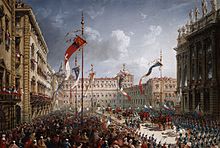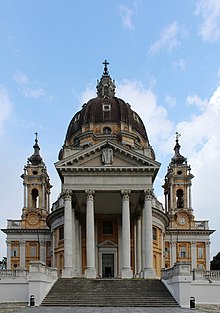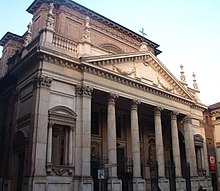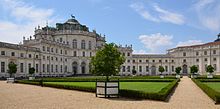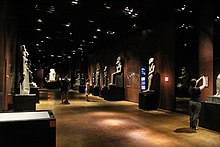Turin
| Turin | ||
|---|---|---|

|
|
|
| Country | Italy | |
| region | Piedmont | |
| Metropolitan city | Turin (TO) | |
| Coordinates | 45 ° 4 ′ N , 7 ° 42 ′ E | |
| height | 240 m slm | |
| surface | 130 km² | |
| Residents | 870,952 (Dec. 31, 2019) | |
| Population density | 6,700 inhabitants / km² | |
| Post Code | 10100 | |
| prefix | 011 | |
| ISTAT number | 001272 | |
| Popular name | Torinesi | |
| Patron saint | John the Baptist ( June 24th ) | |
| Website | www.comune.torino.it | |
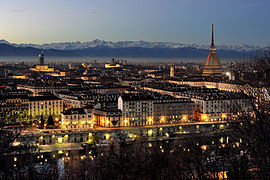
|
||
Turin (Italian Torino , Latin Augusta Taurinorum , Piedmontese Türin ) is a city in northwestern Italy , the administrative seat of the metropolitan city of Turin and the Piedmont region .
The city has 870,952 inhabitants in the metropolitan area, making it the fourth largest Italian city , in the European Union it is at 18th place . Around 1.7 million people live in the agglomeration (2006) and 2.2 million in the metropolitan region .
geography
Turin is at an altitude of about 240 m and has an area of 130 km² . It is a good 100 kilometers away from France in the west and Switzerland in the north, Milan is about 140 km northeast.
The plain in which Turin lies is bordered to the west and north by the Alps and to the south by the Monferrato hills . The Dora Riparia , the Stura di Lanzo and the Sangone flow into the Po near Turin . Much of the city is located in the Po plain west of the river, some smaller districts extend on hills east of the Po, which reach a height of 750 m.
climate
The city has a humid, warm-temperate climate that is continentally pronounced due to its location in the west of the Po plain.
| Turin, Piedmont | ||||||||||||||||||||||||||||||||||||||||||||||||
|---|---|---|---|---|---|---|---|---|---|---|---|---|---|---|---|---|---|---|---|---|---|---|---|---|---|---|---|---|---|---|---|---|---|---|---|---|---|---|---|---|---|---|---|---|---|---|---|---|
| Climate diagram | ||||||||||||||||||||||||||||||||||||||||||||||||
| ||||||||||||||||||||||||||||||||||||||||||||||||
|
Average monthly temperatures and rainfall for Turin, Piedmont
Source: Hong Kong Observatory
|
|||||||||||||||||||||||||||||||||||||||||||||||||||||||||||||||||||||||||||||||||||||||||||||||||||||||||||||||||||||||||||||||||||||||
history
Event history

The city's name comes from tau , a Celtic word that means "mountains". In terms of folk etymology , the Italian name Torino can be translated as “little bull”, which is why a bull is shown on the city's coat of arms. The area was settled in pre-Roman times by the Celtic-Ligurian tribe of the Taurines . One of these settlements was founded in 218 BC. Destroyed by Hannibal during his march towards the Alps.
In the first century BC (probably in 28 v. Chr.) The Romans built here a military camp (Castra Taurinorum), which later became the Emperor Augustus was dedicated (Augusta Taurinorum) . The typical Roman city structure with streets running at right angles to one another has been preserved to this day. The Romano quarter is the oldest part of the city. In Roman times Turin had about 5,000 inhabitants, all of whom lived within the high city walls. In 312 the battle of Turin took place, during which the troops of Emperor Constantine the Great defeated those of his adversary Maxentius .
After the fall of the Roman Empire, the city was conquered first by the Lombards , then by the Franks , and was ruled by bishops. At the end of the 13th century, the Dukes of Savoy took the city. The gardens and palaces were created in the 15th century when the city was rebuilt from scratch. The university was founded in 1404 . Emanuel Philibert made Turin the capital of the Duchy of Savoy in 1563 . From 1564 the pentagonal citadel of Turin was built on the south-eastern outskirts , but it was almost completely demolished in 1857 in the course of the city's expansion.
In 1706 the French besieged the city during the War of the Spanish Succession for 117 days without being able to take it ( Battle of Turin ). According to the Treaty of Utrecht , Savoy received the Kingdom of Sardinia . Architect Filippo Juvarra began redesigning the city, which at that time had around 90,000 inhabitants. After the merger of the two parts of the country Savoy and Piedmont under King Karl Albert , Turin became the capital of the kingdom in 1847.
With the unification of Italy in 1861 , Turin became the Italian capital. King Viktor Emanuel II ruled from here, 14 different castles bear witness to the lordly past. However, the function of the capital was a status that the city had to pass on to Florence four years later . The opening of the Mont Cenis tunnel in 1871 made Turin a major transport hub.
Turin made up for the loss of its capital city function with rapid industrialization , with the automotive industry becoming of paramount importance. Fiat was founded in 1899 and Lancia was founded in 1906 . The International Exhibition of Modern Decorative Art in 1902 is considered the highlight of Art Nouveau . In 1911 a world exhibition took place in Turin , at that time the city already had 430,000 inhabitants.
After the Second World War , the industry experienced an unexpected boom. Tens of thousands of workers, mostly from southern Italy, moved to Turin every year. Turin became a megacity in 1960 and in 1975 reached its maximum population of 1.2 million. The industrial crisis of the 1980s hit Turin hard and the population fell back to below a million.
Urban development
The rectangular grid of the Roman city structure has been preserved to this day in the central old town quarter Quadrilatero Romano . Its main axes in east-west direction ( decumanus ) correspond to today's Via Garibaldi and in north-south direction ( cardo ) to Via S. Tommaso. The Porta Palatina and the Porta Decumana, the remains of which were built in the Palazzo Madama , mark the course of the Roman city wall.
Turin was still influenced by the Middle Ages until it was raised as the capital of Savoy. But then in the 17th century the city was redesigned, which continued into the 18th century, creating an appearance that was almost unique in Europe. The redesign was so radical that none of the 21 parish churches existed or remained unchanged. New corridors were cut through the old buildings: the most important axis, parallel to the Roman cardo along today's Via Roma, aimed from the new ruler's palace on the simultaneously redesigned Piazza del Castello to a castle in the south of the city, while the diagonal Via Po negated the rectangular grid, in order to be aligned with the palace, it also opened up a city expansion area within the newly built bastion belt . Squares kept free from development created a stage for princely celebrations and pageants. The appearance and structure of urban planning thus became a staging of absolutist rulers. Several edicts around 1640 obliged the nobility, who had been given land around the Piazza San Carlo, to build their palaces according to given facade designs in a short time.
In contrast to French architecture, the Turin street fronts had to refrain from a cour d′honneur , they formed a straight line of façades, but on the ground floor level often opening with arcades to the street. Only behind this does the architectural freedom and the baroque variety of room arrangements begin, such as the “characteristic Turin androne, which is usually shaped as a spacious, centralized vestibule that creates a feeling of festive openness between the entrance and cortile ”, the courtyards, stairwells and interiors. The houses were often used jointly by different strata of urban society: the ground floor and back yard by merchants and craftsmen, the piano nobile by the nobility, the upper floors by the lower middle class. Smaller block developments from the 18th century also allow tenement houses with their own structures. The elevation to the Kingdom of 1720 gave rise to new streets ( Via Garibaldi and Via Milano, 1736), representative redesigns ( Palazzo Madama , Piazza Castello ) and new buildings in the city area (pilgrimage church Superga , 1731, Stupinigi Castle , 1734). With the Porta Nuova train station, the capital of the new all-Italian kingdom created an entrance to the city appropriate to the beginning of industrialization.
The new role as an important industrial location (Fiat was founded in 1899) led to urban expansions with predominant rental housing construction, while the Crimea district (created after the Crimean War 1853-1856 and up to Art Nouveau) adorned itself with magnificent villas on the right bank of the Po . Between the world wars, Mussolini's architects renovated parts of the Via Roma around Piazza C. L. N. in the fascist style and the first high-rise buildings were built ( Torre Littoria, 1934).
After the resident population temporarily exceeded the million mark due to the influx of factory workers from the Mezzogiorno in the 1960s, but fell considerably in the recession of the 1980s, Turin acquired a new image: Renzo Piano turned the Lingotto , which closed in 1982, into a trade fair until 1989 - and congress center, the 2006 Winter Olympics required extensive new sports facilities in the city, a new university district was built in the west, the Torino Porta Susa train station was laid underground and in the north-west the industrial wasteland was greened, for example with the Parco Doria .
population
religion
In Turin there has been a Catholic diocese since the 4th century, which was elevated to an archbishopric in 1515 and is today the metropolitan seat of the ecclesiastical province of Turin . 1578 Duke Emanuel Philibert of Savoy the holy grave cloth to Turin convict when the city new residence of the Savoy dynasty was.
See also:
language
In addition to Italian, many Turin residents speak Torinese, a dialect of Gallo-Roman Piedmontese .
politics
As the capital of Piedmont, Turin is also the seat of regional institutions. The regional council ( Consiglio regional ), for example, meets in the Palazzo Lascaris , which was built between 1663 and 1665 . The ruling regional committee ( Giunta regional ) has its seat in Piazza Castello.
Mayor of Turin ( Sindaca di Torino ) has been Chiara Appendino , who is active for the five-star movement , since June 30, 2016 . The city administration ( Giunta Comunale ) has its seat in the Palazzo Civico .
economy
Turin is an important industrial center. The city is best known as the headquarters of the car manufacturer Fiat , which was founded here in 1899. Another famous vehicle manufacturer is Lancia , founded in 1906, taken over by Fiat in 1969 and then incorporated into the group. The Lingotto building was once the largest car factory in the world and was converted into a trade fair, cultural and shopping center after it closed in 1982. Other companies founded in Turin are Lavazza , Martini & Rossi , Kappa , Peyrano Pfati and Caffarel . The aerospace company Leonardo SPA is also important .
With the beginning of the 21st century, the importance of the IT industry in Turin increased. In 2014 the city was included in the Creative Cities Network (Design category) by UNESCO .
Turin is (as of 2011) the second most indebted municipality in Italy after Milan and the municipality with the highest per capita debt in Italy.
traffic
Turin is connected to the Italian motorway network with the A4 (to Trieste ), A5 (to Mont Blanc / France), A6 (to Savona ), A21 (to Brescia ), A32 (to Susa Valley ) and A55 autostrade .
Turin is connected by rail to the Turin – Milan high-speed line , which opened in 2005 to Novara . This reduced travel times to Milan and the major Milan-Malpensa airport . The entire route has been open since 2009, reducing the travel time to Milan from 90 to 50 minutes. There are other direct connections to Rome , Genoa and Naples , among others . A connection to Lyon is also planned. The main train stations in Turin are Porta Nuova , Porta Susa and Lingotto .
The three stations are also important stops on the first line of the Turin Metro . The first section was opened on February 4, 2006. The Turin metro is the first driverless metro in Italy. Local public transport is handled by a well-developed network of tram and bus routes. Torino-Caselle International Airport is located about 15 kilometers north of the city, in the municipality of Caselle Torinese . From there, flights within Europe are offered almost exclusively, including to Frankfurt am Main , London and Paris .
The Servizio ferroviario metropolitano di Torino serves as a S-Bahn -like railway system.
Attractions
Turin has exceptionally significant and historically important architectural monuments, but it must be emphasized that the main attraction is the overall urban development of the city center itself, which was planned in the Baroque period, with its 18 km long arcades, the right-angled street system and the stylistically uniform city palaces.
- The Porta Palatina is the best preserved remnant of the city from Roman times.
- The importance of the otherwise rather simple Turin Cathedral , built in the years 1491–1498, is based on the Turin shroud , a linen cloth that shows the image of a man, which is kept here . It is venerated by pilgrims as the cloth that Jesus was wrapped in in the grave. The dome of the Cappella della Sacra Sindone, in which it is exhibited on special occasions, together with the comparable vault construction in San Lorenzo (Turin) is one of the most extraordinary creations of Baroque architecture.
- The castles and residences of the Dukes of Savoy are world heritage sites . In the center of Turin is the Palazzo Reale , the palace of the kings of Sardinia-Piedmont and, for a short time, of the entire Kingdom of Italy .
- The Palazzo Madama , also part of this world heritage site, consists of an old part and a baroque extension. The old part was built as a city gate in Roman times and expanded into a fortress in the Middle Ages. The new part is the work of the Baroque master Filippo Juvarra . He was also the builder of several residential castles of the dukes of Savoy, later kings of Sardinia-Piedmont and finally of Italy.
- The Palazzo Carignano (1685) is a major work by the architect Guarino Guarini . With its extension (1867–1872) on Piazza Carlo Alberto, the building was intended to serve the new Italian parliament, which, however, left Turin before completion. The facade of the Church of San Filippo Neri was also designed by Guarini.
- Saint John Bosco ("Don Bosco") lived and worked in Turin in the 19th century . He is considered the patron saint of youth. In the district of Valdocco is the Maria-Hilf-Basilica , which he built , where his relics are kept. Valdocco is now a pilgrimage center for young people from all over the world.
- The Piazza Vittorio Veneto , a large square (39,960 m²) created in 1830 near the Po with a view of the hills (Collina di Torino), the Chiesa della Gran Madre di Dio on the other bank and the Villa della Regina.
- One of the landmarks of Turin is the Mole Antonelliana , built between 1863 and 1880 based on plans by Alessandro Antonelli . At that time it was planned as a synagogue. However, the relocation of the Italian capital from Turin to Florence and the escalating construction costs put an end to the plan. Today it houses the national film museum. A spectacular elevator construction pulls a glass elevator floating freely on guide cables through the main room under the dome to the viewing platform.
- The Lingotto building, once the largest car factory in the world built for FIAT, was transformed into a congress center, shopping center, concert hall and hotel according to plans by the architect Renzo Piano . The Art Museum Pinacoteca Giovanni e Marella Agnelli is on the 5th floor of the building . The building is famous for the oval test track on the roof.
Museums:
- The Museo Egizio in a palazzo built by Guarino has one of the most important international collections of ancient Egyptian artifacts. It is the second largest museum in the world (after Cairo) with only Egyptian art. Overall, the collection ranks ninth among the great collections of Egyptian ancient works in terms of the number of finds.
- The Galleria Sabauda , an important art museum, is now located in the Palazzo Reale . Focus: Italian and Dutch painting from the 15th to 19th centuries.
Surroundings:
- The Superga pilgrimage church on the hill of the same name in the east of the city at a height of 672 meters is approached by the Superga cog railway.
- The Stupinigi Castle , 10 km southwest of Turin, is the main work of the Baroque architect Filippo Juvarra, begun in 1729 .
culture and education
Universities and colleges
- University of Turin (Università degli Studi di Torino)
- Polytechnic University of Turin (Politecnico di Torino)
- European Design Institute (Istituto Europeo di Design)
- Accademia Albertina
- SAA - School of Management
- Conservatorio Statale di Musica "Giuseppe Verdi" di Torino
- University of the Salesians Turin
Museums
- Egizio Museum
- Museo Nazionale del Cinema in the Mole Antonelliana
- Museo Nazionale dell'Automobile
- Palazzo Reale
- Galleria Sabauda
- Palazzo Madama
- Museo Civico d'Arte Antica
- Galleria civica d'Arte Moderna e contemporanea (GAM for short)
- Pinacoteca Albertina
- Artillery Museum Turin (Museo Storico Nazionale di Artiglieria) .
- Museo nazionale del Risorgimento , Palazzo Carignano
- Pinacoteca Giovanni e Marella Agnelli
- Museo di Anatomia Criminale "Cesare Lombroso"
administration
Since 2016 Turin has been divided into 8 administrative districts ( Circoscrizione ). These are in turn divided into a total of 94 statistical districts. These are:
- Circoscrizione 1 (78,523 inhabitants (2011), 7.006 km², including the historic old town)
- Circoscrizione 2 (141,344 inhabitants (2011), 18.818 km², including Mirafiori and Santa Rita)
- Circoscrizione 3 (130,709 inhabitants (2011), 8.623 km², including Pozzo Strada and Borgo San Paolo)
- Circoscrizione 4 (98.787 inhabitants (2011), 9.183 km², including San Donato and Parella)
- Circoscrizione 5 (126,666 inhabitants (2011), 15,583 km², including Borgo Vittoria and Barriera di Lanzo)
- Circoscrizione 6 (107,369 inhabitants (2011), 25.206 km², including Regio Parco, Barca, Bertolla and Villaretto)
- Circoscrizione 7 (89,448 inhabitants (2011), 22,582 km², including Aurora, Vanchiglia and Madonna del Pilone)
- Circoscrizione 8 (134.028 inhabitants (2011), 23.165 km², including San Salvario, Borgo Po, Lingotto and Filadelfia (with the Olympic village))
Sports
The city is home to the soccer clubs Juventus Turin and FC Turin , two of the most successful clubs in the history of Italian football . Juventus are Italian record champions with a total of 35 championship titles and have been Italian champions eight times in a row since 2012 . The club has been playing in the 41,500-seat Allianz Stadium (until 2017 Juventus Stadium) in the north of the city since 2011 , while the seven-time Italian champions FC Turin play their home games in the Olympic Stadium. In 1934 and 1990 , the Stadio Municipale Benito Mussolini (now Turin Olympic Stadium ) and Stadio delle Alpi stadiums of the World Cup took place in Turin .
Between 1935 and 1955 , the internationally important Gran Premio del Valentino and Gran Premio di Torino automobile races took place a total of seven times in the Parco del Valentino in Turin . Big names like Tazio Nuvolari , Achille Varzi and Alberto Ascari entered the winners list . In 1952 and 1955 the Gran Premio was a Formula 1 race without world championship status . In 2006 Turin was the venue for the XX. Winter Olympics .
In 2007/08 and 2008/09 the final 8 basketball tournament of the ULEB and EuroCup was held in Turin . In 2008 the tournament took place in the Palavela , in 2009 the Palasport Olimpico served as the venue. In 2008 the European Rhythmic Gymnastics Championships were held in the Palasport Olimpico.
In 2014, Turin’s Juventus Stadium hosted the UEFA Europa League final .
Personalities
Famous personalities of the city are included in the list of personalities of the city of Turin . These include various rulers from the Savoy family as well as the mathematician Joseph-Louis Lagrange , the football coach Vittorio Pozzo , the pianist and composer Ludovico Einaudi , the Nobel Prize winner Rita Levi-Montalcini and the music producer Gigi D'Agostino .
Town twinning
-
 Bacau , Romania
Bacau , Romania
-
 Bagneux , France
Bagneux , France
-
 Bethlehem , Palestinian Territories
Bethlehem , Palestinian Territories
-
 Campo Grande , Brazil
Campo Grande , Brazil
-
 Chambéry , France
Chambéry , France
-
 Cordoba , Argentina
Cordoba , Argentina
-
 Detroit , United States
Detroit , United States
-
 Esch an der Alzette , Luxembourg
Esch an der Alzette , Luxembourg
-
 Gaza , Palestinian Territories
Gaza , Palestinian Territories
-
 Glasgow , Scotland
Glasgow , Scotland
-
 Haifa , Israel
Haifa , Israel
-
 Cologne , Germany
Cologne , Germany
-
 Lille , France
Lille , France
-
 Liege , Belgium
Liege , Belgium
-
 Nagoya , Japan
Nagoya , Japan
-
 Quetzaltenango , Guatemala
Quetzaltenango , Guatemala
-
 Rotterdam , Netherlands
Rotterdam , Netherlands
-
 Shenyang , People's Republic of China
Shenyang , People's Republic of China
-
 Tirana , Albania
Tirana , Albania
-
 Volgograd , Russia
Volgograd , Russia
Web links
|
Further content in the sister projects of Wikipedia:
|
||
|
|
Commons | - multimedia content |
|
|
Wikinews | - News |
|
|
Wikivoyage | - Travel Guide |
- City of Turin website (Italian, English, French)
- Turin on gedenkorte-europa.eu, the homepage of Gedenkorte Europa 1939–1945 (German)
Individual evidence
- ↑ Statistiche demografiche ISTAT. Monthly population statistics of the Istituto Nazionale di Statistica , as of December 31 of 2019.
- ^ Stefano Molina, Fondazione Giovanni Agnelli, Popolazione torinese. Ieri, oggi, domani; PDF
- ^ Heinz Schomann: Piedmont - Liguria - Aosta Valley. Art monuments and museums (= Manfred Wundram [Hrsg.]: Reclams Art Guide Italy . I, 2). Philipp Reclam jun., Stuttgart 1982, p. 427 .
- ↑ Vera Comoli: Turin. The invention of a baroque capital of absolutism, in: Planstädte der Neuzeit . Publication accompanying the exhibition at the Badisches Landesmuseum Karlsruhe, 1990, pp. 133–142.
- ^ Christian Norberg-Schulz: Spätbarock und Rokoko, DVA: Stuttgart, 1980, p. 130.
- ^ Heinz Schomann: Piedmont - Liguria - Aosta Valley. Art monuments and museums (= Manfred Wundram [Hrsg.]: Reclams Art Guide Italy . I, 2). Philipp Reclam jun., Stuttgart 1982, p. 427 .
- ↑ In detail in the Italian Wikipedia: it: Torre Littoria (Torino)
- ↑ Presentation of the Giunta regional on the official website of the Piedmont region
- ↑ Presentation of the mayoress on the Turin city website
- ↑ Biography on the website of Chiara Appendino
- ↑ Presentation of the city administration on the website of the city of Turin
- ↑ Debt ranking of the Italian municipalities (archived in the Internet Archive )
- ↑ Information on the Turin Airport website
- ^ Historical view of the fortress as a digitized version
- ↑ The Circoscrizione on the Turin website (Italian), accessed on October 13, 2017.
- ↑ Bethlehem Twinning Cities (English)



